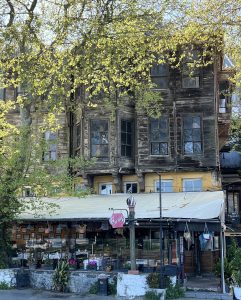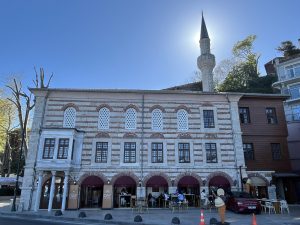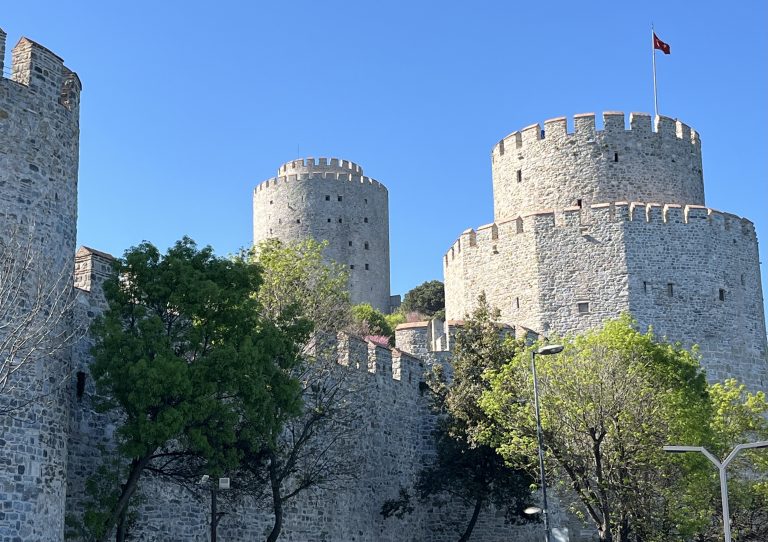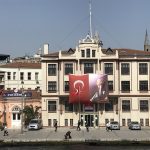“Roman (European) Castle”
 The well-heeled Bosphorus suburb of Rumeli Hisarı is named after the huge castle built here by Mehmet the Conqueror in 1452 as part of his preparations for the conquest of Constantinople. Today it’s a great place to come to eat, especially on Sundays when brunching is a big thing at a string of inviting cafes such as Sade Kahve and Lokma.
The well-heeled Bosphorus suburb of Rumeli Hisarı is named after the huge castle built here by Mehmet the Conqueror in 1452 as part of his preparations for the conquest of Constantinople. Today it’s a great place to come to eat, especially on Sundays when brunching is a big thing at a string of inviting cafes such as Sade Kahve and Lokma.
The suburb struggles up the steep hillside behind the castle to Rumeli Hisarı Üstü where it meets up with the campus of the prestigious Boğaziçi Üniversitesi (Bosphorus University). Most visitors stop for a brief look at the castle, then speed on through to Emirgan and the Sakıp Sabancı Museum.
Backstory
Although Rumeli Hisarı is most obviously associated with the story of the Conquest of Constantinople in 1453 its site, at the narrowest point of the Bosphorus, ensures that it has a much longer history. It was here in 512 BC that King Darius the Great of Persia is believed to have built a bridge of boats over which his 700,000-strong army of men crossed the strait on their way to battle the Scythians. Today visitors can brunch in Duatepe Park, seemingly sited on the exact lofty spot where King Darius sat to watch the work in progress.
The castle
In 1452 Sultan Mehmed II determined to capture Constantinople from the much weakened Byzantine emperors. As part of the preparations for his assault on the walls which had protected the city for best part of a thousand years he decided to built a castle at the narrowest point of the Bosphorus facing the castle at Anadolu Hisarı (“Asian Castle”) which had been built by his great-grandfather, Sultan Beyazıd I.
According to the 17th-century travel writer Evliya Çelebi, Mehmed asked the emperor for permission to build a hunting lodge and was told that he could build one no bigger than the space that could be covered by a cowhide. Mehmed then cut the hide into strips and laid them out in a circuit covering some 31,000sqm, a space big enough to encompass one small, three large and 13 watch-towers. Since this is effectively the same story as Virgil wrote about Queen Dido and the birth of Carthage it is presumably entirely fanciful.
Once the castle had been built it was used to prevent grain-carrying ships sailing down the Bosphorus to supply Constantinople, thus further weakening the city before the assault. After the fall of the city it was used for collecting customs and then as a prison. Over the centuries it was badly damaged by fire and earthquake, and by the 19th century photographs showing houses inside the walls confirm that the castle had entirely lost its defensive function.
The most prominent tower is the round Sarıca Paşa/Fatih Tower to the north which reaches 28m in height. The Halip Paşa Tower by the water is 12-sided and reaches 22m. The circular Zağanos Paşa Tower to the south is only 21m high. The curtain walls stretch for 250m with main gates cut into them close to the main towers. A rock-cut cistern under the castle supplied it with drinking water. The small mosque in the grounds was initially replaced with a mescid in the 16th century but by the 20th century this had vanished – only to be rebuilt in the 21st!
Although it was extensively restored in 1973 as part of the celebrations for the 500th anniversary of the conquest of Constantinople the castle remains, like Yedikule and the City Walls, a rather under-recognised tourist attraction. You can go inside (closed Mondays, admission €6) and walk around the walls to admire the views but nothing has been done to bring to life the rich history attached not just to the castle but also to its site.
Although the castle sounds like a good place to bring children parents need to be aware that safety precautions are not the best.
 Around Rumeli Hisarı
Around Rumeli Hisarı
Aside from the castle, you might want to take a quick look at the prominent Hacı Kemaleddin Cami on the waterside. It was rebuilt in 1746 on a site probably occupied by a mosque since the time of Sultan Mehmed II. The smaller Ali Pertek Cami at the foot of a steep hill running up to the Bosphorus University started life in the 17th century but was rebuilt in the 1960s and was completed renovated again in the 2010s.
The mosque is just round the corner from the extraordinary red-brick Perili Köşk (Fairy Mansion), originally built in the 1920s for Yusuf Ziya Paşa, a member of the Egyptian Khedive Abbas Hilim’s entourage. The building work was brought to a halt by the First World War and only completed in 2000. Today the building houses the Borusan Contemporary Art Gallery, a private art gallery open on Saturdays and Sundays only.
The Perili Köşk sits more or less beneath the Second Bosphorus Bridge, the Fatih Sultan Mehmet (FSM) Köprüsü, built in 1988. Also in its shadow is the five-storey Tophane Müşiri Zeki Paşa Yalısı (Filinta Mustafa Yalısı), one of the few yalıs (waterside mansions) built of stone rather than wood. Designed by Alexandre Vallaury in the 19th century, the yalı remained in the possession of minor members of the imperial family until the collapse of the Ottoman Empire in 1923. In 2019 it sold for around $100 million. “Filinta Mustafa” (1849-1914) was a general and statesman during the reign of Sultan Abdülhamid II.
Should you be heading downhill from Rumeli Hisarüstü you might want to look out for the Paşa’nın Kütüphanesi (Pasha’s Library), a hanging library that once belonged to Ahmed Vekif Paşa (1823-91), the brains behind the first modern Turkish dictionary. Vekif had owned much of the land now occupied by the Bosphorus University but was forced to sell it to pay his debts, retaining only this wonderful bolthole with its spectacular views over the Bosphorus. After his death the library was modernised by Alexandre Vallaury in 1902. It was here in the 1960s that the Black American writer James Baldwin worked on his novel, Tell Me How Long The Trains’s Been Gone; the Library also provides the setting for some of the more atmospheric scenes in Maureen Freely’s novel, Enlightenment.
Transport info
Most buses plying the Bosphorus coast road pass through Rumeli Hisarı. On a sunny day you might prefer to get out in Kücük Bebek and walk along the coastal promenade to the castle – most people will be able to do this in half an hour or so.
You can also get to Rumeli Hisarüstü by Metro and then walk down the steep hill to the water. Buses from Taksim also run to Rumeli Hisarüstü passing through Etiler but at busy times the narrow road is a terrible traffic bottleneck – better take the Metro!
Nearby areas


